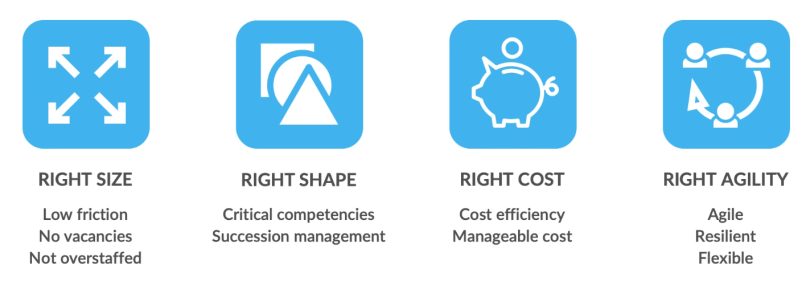Workforce planning is critical for the health and growth of any organization. As an HR professional, you know how much of an undertaking it is to hire the right people with the right skill set at the right time. Then add on the responsibilities of budgeting for new hires and internal promotions, keeping current employees engaged and retention rates high, all while growing a business — it's overwhelming.
To help you keep calm and workforce plan on, we created a brief guide that covers the basics of workforce planning. Feel free to click on the links below to jump ahead.
See how your employer brand is performing in AI tools like ChatGPT and Google.
Table of Contents
- What is Workforce Planning?
- Benefits of Strategic Workforce Planning
- Stages of Strategic Workforce Planning
What is Workforce Planning?

Workforce planning is the process of auditing, predicting and managing the employment needs of your company in relation to its greater strategic business goals.
Think about it this way, your product team is constantly evaluating the product — what customers like and want more of — while at the same time predicting what’s going to be the next big thing. Similarly, your company needs to continuously evaluate its people — what they like and don’t like in their roles — as well as how the company is projected to grow and who will need to be hired, promoted or reorganized to meet those needs.
What is Workforce Planning?
When it comes down to it, the goal of workforce planning is to help your workforce meet the following criteria as closely as possible:

Benefits of Strategic Workforce Planning

Workforce planning is a massive undertaking, especially the first time you do it. It can be difficult to know where and how to start as well as what resources are required to build a strategic workforce plan. Before we delve into the details, check out a few benefits of creating a workforce plan that make the effort worthwhile.
-
Help teams justify additional hires
-
Save time and money by anticipating growth and change
-
Prepare for organizational changes proactively
-
Support finance team in budgeting for future workforce needs
-
Collaborate with the strategic business planning process
-
Recognize gaps in the workforce that need filling
-
Identify critical roles and teams to expand for growth
-
Balance business goals alongside hiring
-
Prioritize employee retention and engagement to reduce hiring needs
Stages of Strategic Workforce Planning

Analyze Strategic Direction
In order to plan for future workforce needs, you first need to analyze the current state of your workforce. Start by answering these questions:
-
What departments are running lean and could use additional support?
-
What is the manager-to-direct report ratio?
-
What individual contributors are ready for a promotion?
-
Do current employees need additional training to advance their careers at the company?
-
Is there a skills gap among current employees that needs to be filled by an external hire?
-
How long do employees typically stay at your company?
-
Why do employees leave your company?
To answer the majority of these questions, you need to take a deep dive into your overall employee lifecycle, which will also help you better understand why people apply for roles at your company and why they leave.
Additionally, look carefully at your recruitment metrics so you can better optimize your strategy.
Forecast Workforce Supply & Demand
Now that you've analyzed the current state of your workforce, look more closely at the employees you currently have, otherwise referred to as your workforce supply, and predict how their roles will change over time. These factors play a significant role in how, who and when you should hire candidates. Key areas to consider are:
-
Employee retention: Determine roles that can be filled by internal candidates through promotion or professional development
-
Turnover: Anticipate turnover by knowing individual employee goals and career paths.
-
Departmental attrition: Are certain departments or roles becoming obsolete or less valuable to the company, and if so, will you need to downsize or reorganize.
-
Physical office space: Is there enough physical office space and equipment to sufficiently support more employees?
-
Recruiting resources: Identify which roles need to be filled by external candidates what resources your team will need to recruit them — professional recruiters, money for job boards and advertisements, etc.
-
Communications resources: Recruiting and building an employer brand consumes a significant amount of time and resources. Check to see if anyone on your marketing team has the bandwidth to help out.
Once you’ve estimated your current workforce supply, you’ll want to consider the demand of each area. Understanding the difference between supply and demand in your workforce will help you identify gaps between what resources are readily available and what resources your organization needs to grow on track. In terms of workforce demand, you’ll want to look at:
-
Employment market: Take a look at the recruitment market to see which roles are in high demand and will be difficult to hire.
-
Upcoming funding: What roles are critical right now and which ones can wait until you raise more capital?
-
Skills training: Will you need to train new or current employees skills to ensure they will keep up with change, or will you need to hire already skilled candidates for the roles.
Keep in mind the supply and demand of workforce planning will change over time so it's important to include your team in the workforce supply planning process because the decisions made will ultimately affect their jobs and careers.
Create a Workforce Planning Budget
At this stage, you should have a fairly detailed blueprint of who you have employed today, who you will need in the future and any gaps between the two. Now, you need to start prioritizing your roles by the most difficult to fill, highest priority and cost-per-hire.
How you prioritize roles will also depend on your external hiring and internal retention budgets. To hire talented candidates — and pay them what they’re worth — you need to determine a budget through workforce planning.
Figure out how long it takes to hire someone and how much it will cost by comparing your external hiring budget to your current recruitment metrics. By looking at the metrics, you should also be able to pinpoint areas of the recruitment strategy that need improvement.
Set a Hiring Timeframe

From here, build out a timeline that prioritizes certain roles and takes into account how long it will take to hire each role. This timeline can span between one year to 10 years depending on your strategy. Regardless of how far out your strategy spans, include intermittent short term goals throughout the plan to ensure you're always pacing on track.
Also, keep in mind this plan is not set in stone, it will fluctuate over time and require adjustments along the way.
Reevaluate Workforce Plan
Once you’ve created a workforce plan, you’re not done. In fact, you will constantly be monitoring the workforce needs of your company as business goals change and your internal workforce evolves. It's important to frequently get feedback and buy-in from employees, especially as the company grows.
If you create a culture that is open to having tough conversations with employees about their roles, performance and future career, you will be significantly better equipped to anticipate and adjust your workforce plan as changes occur. Employees will also be more keen to stay at your company and refer cohorts to open roles, thus further simplifying your recruiting and retention process. Even as the plan you create changes over time, it will always be a guideline for your teams to assess the effectiveness of their strategies and keep them on track over the course of several years.





